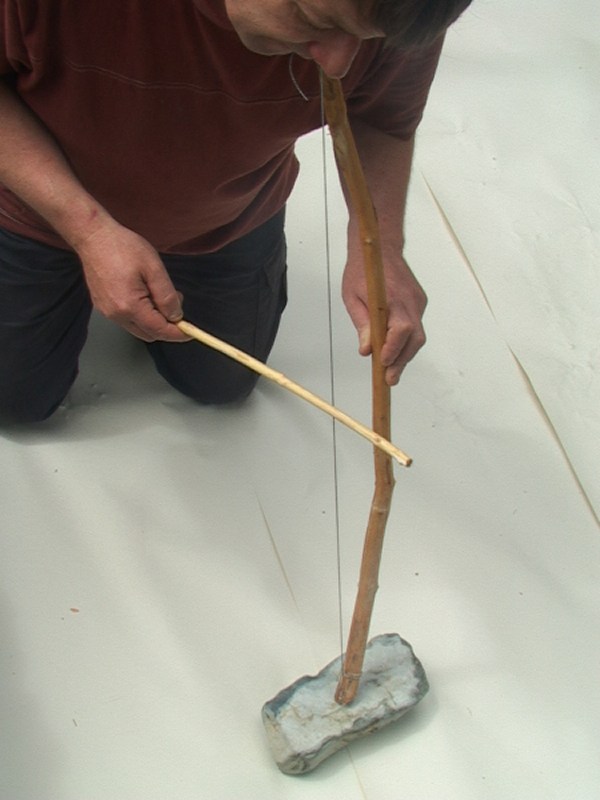Animal Horns
Animal horns were and are still a common source of musical horns and trumpets. Hollow animal horns such as those of cattle, sheep, goats or antelope were probably the first lip reed instruments. With the advent of agriculture horns were easily accessible and simple to construct. All that was required was to cut the end off and carve a cushion mouthpiece or to drill a mouthpiece into the side of the horn near the closed end.
Horns of this nature a remain a significant part of many cultures and still played throughout sub-Saharan Africa while a ram’s horn when carved and blessed by a rabbi becomes the shofar, an important part of the Jewish faith.
In Ireland there have been no animal horn finds from prehistory. However, one carved cow horn of unknown age was found during renovation in a public bar in
Connemara. The evolvement of the great cast bronze horns of the later Bronze Age and sheet bronze trumpets of the Iron Age would most likely have had its origins in animal horns. Their flowing curves and regular shape closely resemble cattle horns and it is thought that they were evolved as a part of a bull cult. Many examples of similar cults are found in the prehistoric world.
Tuning
The tuning and tone of the instrument is dependent on the length and width of the original horn. The mouthpiece is cut into the side of the horns or into the end tip.
Bodhrán
The Bodhrán or ‘deafner’ is a simple frame drum. A frame drum may be best described as a narrow hoop of wood with an animal skin stretched and secured to one side. Frame drums are common both in prehistory and the present day. There is uncertainty as to the actual age of the bodhrán tradition in Ireland but the unique swinging sideways style of playing which is employed only in Ireland probably indicates that the bodhrán has been a part of Irish music since its earliest origins.
While it is true to say that probably none of the music from prehistoric Ireland survives into the present, yet the bodhrán is a living part of Irish music. It produces widely varied and complex rhythms which are ideally suited to the flowing intricacies of the tunes. In recent times the sound of the bodhrán has begun to move out of its traditional role in Irish music into new disciplines. Experimental collaboration with African drumming and dance rhythms have proved very successful and clearly point to a new and bright future for it.
Bone Flutes and Whistles
The oldest surviving purpose made musical instruments are bone and ivory whistles and flutes found in caves in Southern Germany and France. The earliest date from 40 to 35 thousand years ago. Recent research indicates that they were associated with acoustically rich areas in caves that also include rock art. Experiments have indicated a possible link between the visual images in caves and the surrounding acoustic properties, suggesting that music may have been played as part of a ritual which also included rock art.
A collection of bone whistles made from the leg bones of cranes were recovered in Northern China and are dated at 9,000 years old. A reproduction Chinese flute was presented to Ancient Music Ireland at the 2nd International Study Group of Music Archaeology in 2,000.
Many types of bone is used for flutes and whistles. Most commonly employed are the leg or wing bones of birds. The oldest flute from Geissenklosterle in Germany is fashioned from the radius of a Hooper swan. Animal bones from sheep or goats are also employed and in certain cases even human bones. The earliest known bone flutes in Ireland date from the Viking era but there can be no doubt that bone instruments were common in Ireland much earlier and were probably introduced with the first human habitation after the Ice Age. The simple tin or penny whistle, which is played so proficiently in Irish traditional music has its origins in a bone ancestor.
Reference
Hein, Wulf/Seeberger, Munzel Friedrich, Suzanne. The Geibenklosterle Flute Discovery, Experiments, Reconstruction. The Archaeology of Sound: Origin and Organisation. Paper from the 2nd Symposium of the International Study Group on Music Archaeology at Monastery Michaelstein, 17-23 September, 2000. Studien zur Musikarchäologie III, Orient-Archäologie 10, Rahden/Westf. 2002.
Xinghua, Xiao. On the Musical Civilisation of the Neolithic Age in China as illustrated by ancient bone futes (9,000 to 7,800 years ago). Unearthed at Jiahu Henan Province. The Archaeology of Sound: Origin and Organisation. Paper from the 2nd Symposium of the International Study Group on Music Archaeology at Monastery Michaelstein, 17-23 September, 2000. Studien zur Musikarchäologie III, Orient-Archäologie 10, Rahden/Westf. 2002.
Hickmann, Ellen. Neolithic Bone Flutes from Jiahu China. An Introduction. The Archaeology of Sound: Origin and Organisation. Paper from the 2nd Symposium of the International Study Group on Music Archaeology at Monastery Michaelstein, 17-23 September, 2000. Studien zur Musikarchäologie III, Orient-Archäologie 10, Rahden/Westf. 2002.
Bow Harp
The bow and arrow is a very curious musical instrument. The fact that it has another purpose as a weapon is unusual. It is interesting to pose the question which came first. It is not hard to imagine somebody tying a string bow and arrow onto a piece of stick tight enough to bend the stick and thus tension the string so that when tapped lightly with a short stick it would sound.
The tone can be amplified and varied with the mouth cavity of the player or by attaching a hollow vessel at one or other end. Thus, the first stringed instrument appears, yet one day the players young son might be fiddling around so that he accidentally notches the tapping stick on the string and then pulls with his finger and lets go so that the stick flies through the air.
Of course, he wants to do it again and then he wants to show others until someone realises what had just been invented. Which came first? Native tribes in Central Africa still employ both the bow and arrow and the musical bow in their hunting and music traditions.
Shell musical horns
Sea Shells
Sea shells are common in ancient cultures and are used as signal and ritual instruments. Examples survive from South America, Roman and Greek civilizations and ancient Eastern cultures.
Small, medium and large sea snail shells also known as Triton conch are naturally occurring and are fashioned into musical instruments to suit the purpose. The mouthpiece may be at the pointed end or inserted in the side of one of the spirals. Sounds range from a high note (small shell) to a deep booming tone (large shell).
Successful shell horns have been made by Ancient Music Ireland using large Triton conch shells from Fiji and other species of sea snail from the Gulf of Mexico. Continuing exploration and practice have shown that such instruments can be played in surprisingly complex musical situations.
Reference:
Both, Arnd Adje. Shell Trumpets in Mesoameriea. Music – Archaeological Evidence and Living Tradition. Music-Archaeological Sources: Finds, Oral Transmission, Written Evidence. . Paper from the 3rd Symposium of the International Study Group on Music Archaeology at Monastery Michaelstein, 9-16 June, 2002. Studien zur Musikarchäologie IV, Orient-Archäologie 15, Rahden/Westf. 2004.
Silver Pipes of Ur, Mesopotamia
Circa 2.500 BC
In the year 2,000 AD, Dr. Bo Lawergren presented a paper on the reconstruction of the silver pipes of Ur, Mesopotamia from 4,500 years ago to the 2nd International Study Group of Music Archaeology.
The presentation included the first new set of the silver pipes of Ur made in modernity. They were fitted with reeds taken from drones of Northumbrian pipes. They were sounded for the first time at this conference by Simon O’Dwyer and a number of notes were achieved. Subsequently Dr. Lawergren made a second set for and presented them to Ancient Music Ireland. This set has been studied and copied by Barnaby Brown.
Reference:
Lawergren,, Bo. Extant Silver Pipes from Ur, 2,450 BC. Music Archaeology of Early Metal Ages. Paper from the 1st Symposium of of the International Study Group on Music Archaeology at Monastery Michaelstein, 18-24 May, 1998. Studien zur Musikarchäologie II, Orient-Archäologie 7. Rahden/Westf. 2000.
Stone Flutes and Whistles
Many old musical cultures around the world employ simple musical instruments fashioned from naturally occurring materials. These naturally occurring ‘stone instruments’ are formed from reefs that were perforated by colonies of sea creatures and then broken up by erosion. In certain places small stones may be found on the sea shore with deep narrow holes drilled into them by shellfish. Sometimes these may be interconnected inside.
While rare and hard to find, a good example may allow for several notes to be played by blowing across one hole whilst opening and closing the others with the fingers. Ocarinas from the Eastern Mediterranean and similar Eastern bowl flutes originate from sea stones with naturally occurring holes. Examples with one or more holes may play a number of notes. Ancient Music Ireland have collected examples of flute stones from a number of beaches around the coast of Ireland.
Sone percussion
It is the most natural thing in the world to take a small stone into each hand and click them together in a rhythmic beat. The size, shape and density of the stones will determine the sound of the click. The harder the stone the sharper the sound. Certain large rocks were revered for the ringing sound thy made when struck. Many, known as ringing rocks survive in situ and some bear the marks of being repeatedly struck over a long period of time. Flat rectangular stones of lengths that vary from short to long if carefully chosen, could be tied together, presented side by side in a line and struck with wooden sticks. If each was picked for the particular note it produced then together, they would make up an early marimba which would sound very good in the hands of a proficient player.
Reference
Reznikoff, Egor, Prehistoric Paintings, Sound and Rocks. The Archaeology of Sound: Origin and Organisation. Paper from the 2nd Symposium of the International Study Group on Music Archaeology at Monastery Michaelstein, 17-23 September, 2000. Studien zur Musikarchäologie III, Orient-Archäologie 10, Rahden/Westf. 2002.














